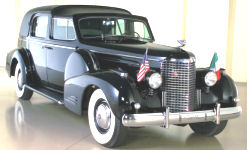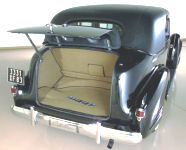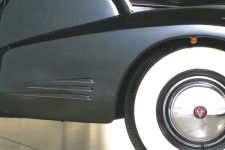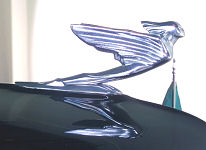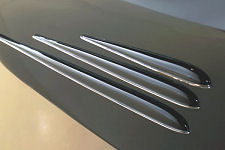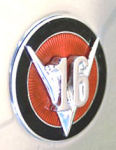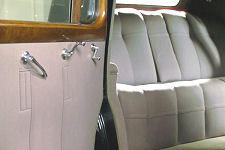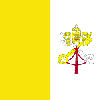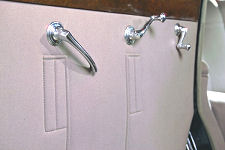[ last update:
03.28.2012 ]
The (new) Cadillac Database©
The Cadillac
V16
The 1938 Town
Car
known as "The Vatican V-16"
Return to The (New) Cadillac Database© Index Page
or to the "V-16" index page
A Tale of a Few Cities1
[ Some fiction but mainly facts ]
________________________________________
1 This tale was told previously by me
in the CLC Self Starter for October 1976; it was entitled Roman Holiday for
Beautiful Unrestored 1938 Cadillac V-16 Town Car Type #9053. The story appeared
also that month in AACA's Antique Automobile

Paris
June 3, 1938. It is a balmy, early summer day. The knobbly platanes
(plane trees) lining the inner alley of the Avenue des Champs Elysées are in
full bloom. The only sounds to be heard above the dulling drone of mid-morning traffic on
the busy avenue is the chirping of zillions of sparrows and the cooing of fat, gray
pigeons all vying for croissant crumbs thrown teasingly in their midst by a
couple of American tourists clothed in pastel-colored leisure wear. They are seated
at the dark brown wicker tables, beneath the red awning, on the sidewalk outside Le
Sélect, a posh café at #142 Champs Elysées.

Detroit
More than 4000 miles away, in a working-class suburb of Detroit,
John Kubowski, 50, is getting ready for the morning commuter trip to the Cadillac
plant on Clark Street. "JK" or "Jake" to his buddies in the trim shop,
John has spent the last fourteen years trimming the interiors of the world's finest luxury
cars. He knows he will never own one, yet he prides himself daily in his art. He learned
it from his father, Big John Kubowski who never lost his Polish accent, even
after twenty years in America.
Jake is a master at pleating and tufting. Were it not for the
Union bosses who keep telling him to "slow it down", John reckons he could trim
that Fleetwood town car in just a couple of days. The job involves hanging the headliner,
trimming the lower quarters, arm rests and inner door panels, laying all the pads and
carpets, popping the Marshall springs into the seat boxes, padding them, pleating the
seats and seat backs and finishing off with the bellows strip, Randall moldings, windlace
and wire-on lace.
He hopes to finish the V-16 tomorrow. If only he were paid by the
job and not by the hour, Jake probably would be a richer man !

Back to Paris
Next door to Le Sélect, stretching from #144 to 146 of
the famed Parisian avenue, the Etablissements Loiseau, Paris' central Cadillac
agency, opened for business just two hours ago. In the shade of the broad entrance
porch, hand-over-hand clasped behind his back and striking a dignified pose in his
anthracite, 3-piece suit and light gray fedora, the concessionnaire [dealer] is
standing outside the showroom, hoping to ensnare some of the passers-by who stop to admire
the shiny cars behind the vast plate glass windows.
Business has been good these last ten years for "Monsieur
Georges" who took over the premises from a failing Renault franchise. His
clientele reads like a Who's Who. It includes royalty, heads of state, stars of
the stage and screen as well as a number of untitled and sometimes enigmatic millionaires.
His most faithful customer is Countess Hélène du Bourg de Bozas.
She has ordered a new model from the Etablissements Loiseau every year since
1929. She has introduced him also to dozens of buyers and potential buyers in the
years since she bought her own, first Cadillac right off the exhibition stand at the Grand
Palais (the venue of the annual Paris Salon). Right after, Black October,
this was considered quite a feat, even in France.
That first Cadillac was an elegant Fleetwood town car with black
fenders and hood, dark green body up to the belt, black leather roof covering, imitation
landau bars on the quarters, pale green wheels and red pinstripes highlighting the broad
belt molding and the raised Le Baron panel sweeping across the hood.
Foremost among the many new clients that Countess de Bozas has
brought Monsieur Georges is her long-time acquaintance and close friend Rosario,
whom she introduced to him as Madame la Comtesse de Larrechea de Schiffner.
Rosario is the Italian widow of German millionaire, Baron Friedrich Von Schiffner, a
former flying ace from WW1 and a bosom buddy of the Red Baron.
In 1936, shortly after the tragic loss of her husband in a stupid
air show, Rosario (Comtesse numéro deux, as Monsieur Georges
calls her) had bought from him a large, Series 75 limousine. She was much
enthralled with it's lush interior and unfailing reliability (well, almost).
Alessandro, the family chauffeur, had only once had to bring it in to Monsieur Georges
for a minor adjustment to the Syncro-Mesh transmission.
Gabriella and Alessandra, the Countess' grown children having
moved to Rome shortly after their father's death, she had sold her hôtel particulier
[as are known Paris' largest private homes] on Avenue Foch and moved into a rented suite,
next to the one occupied by Coco Chanel, in the stellar and opulent Ritz Hotel, facing the
Place Vendôme2.
__________________________________________________________
2 Most of you probably will associate
that hotel with the late Diana Spencer, Princess of Wales and her suitor, Dodi Fayed. It
was here that began the tragic, high-speed car chase between Dodi's rented Mercedes and a
group of frenzied paparazzi that culminated in that horrendous collision,
claiming the lives not only of the beloved Princess and her beau, but also that of
the (inebriated?) chauffeur, Monsieur Paul.
Rosario, aka "Countess number two", needed a reliable
road car for her regular trips between the Ritz and the home of her daughters on Rome's Via
Coliseo. The "75" limousine had served that purpose well but had clocked up
some 20,000 kilometers. She had been advised by Monsieur Georges that now might
be an opportune time to trade the black limousine for a new model.
Once again, she would let Alessandro sell the limousine on her
behalf; he had many chauffeur friends who were always on the lookout for well-kept, low
mileage limousines like this one. He always got a handsome tip from the Countess, after a
successful sale.
Rosario was calling on Monsieur Georges today to inquire
about the availability of a model she had greatly admired just a couple of months earlier
at the Motor Show in Geneva, Switzerland. It was a dark blue Series 90
formal limousine powered by an all-new, ultra-silent sixteen-cylinder engine. The sales
people on the Cadillac stand had promised they would have their principals in America send
her by mail a portfolio of all the new sixteen-cylinder models. There were eleven body
styles she could choose from, in addition to the one on display.

The time is 11 a.m. A long, shiny black 1936 Cadillac Series
75 limousine draws up smoothly, silently, outside the Cadillac showrooms of
Georges Loiseau on the Champs Elysées. A capped chauffeur in gray gloves glides
around the car to the right-hand rear passenger door. He opens it. An elegant woman
alights, carrying a dainty beige parasol. Her peachy smooth complexion beneath her
broad-brimmed lace capeline belies her true age which she has claimed for the
last five years to be "a half century, more or less". In fact it was
"more" but she could still quite easily pass for "less".
Monsieur Georges crosses the broad, sun-drenched
sidewalk to meet her. She extends her gloved right hand, palm downwards. He clasps lightly
the extended fingers and bows with deference, his lips just a half-inch from the white
lace glove. Bonjour, Madame la Comtesse, he murmurs obsequiously. They pace
together the few steps to the open showroom door as pigeons and sparrows alike scurry on
all sides with their wings only barely deployed.
Stepping aside to allow her to precede him, Monsieur Georges
bows once again. "Please, Madame..." The Countess enters the
cool, hushed premises. She is followed by the concessionnaire and, at a
respectable distance, by Alessandro, her faithful chauffeur.
There is only one Sixteen on the floor, a black Fleetwood
style #9019 sedan for five passengers, with light gray broadcloth upholstery. After a
cursory inspection, Rosario whirls around on her right heel. She addresses the chauffeur:
"Alessandro, mon brave, ... you have the catalog? Yes?"
The chauffeur flicks open a soft, black leather document case,
extracts a reddish-brown, stiff card portfolio
and hands it to the Countess. It is entitled The New Cadillac Sixteen.
Inside are a dozen stiff
cards, each one measuring around 11x13 inches and all in brilliant color. They
illustrate beautifully and perfectly the twelve models making up Cadillac's
top-of-the-line offerings for the year. The Countess picks the first one. "Your car,
here, it is très élégante," she smiles, handing the card peremptorily to Monsieur
Georges, "Mais voilà, THIS is
the model I desire."
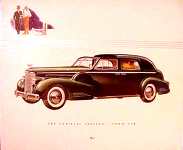
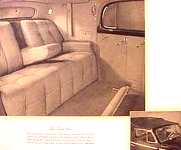
Merchandising card for 1938 Cadillac V-16 Fleetwood style #9053
[ Obverse on the left, reverse on the right ]
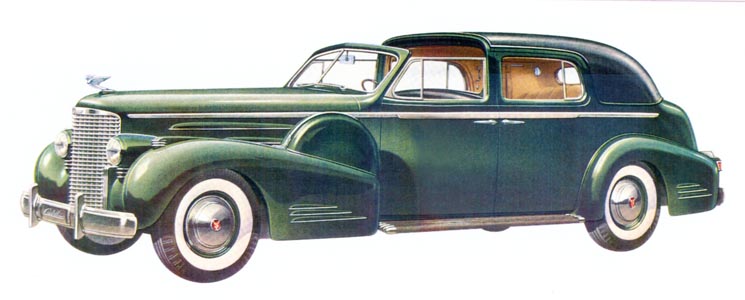

|
Illustrated on the obverse
of the card [above] is a stunning artist's representation of the Fleetwood town
car, style #9053. It is painted bottle green and has a black leather roof covering. On the
reverse is another artist's impression of the luxurious passenger accommodations, done in
pleated taupe broadcloth; there is also a smaller, bird's eye view of the chauffeur's
compartment with its black leather canopy in place.
"I should be glad to order this model for you, Madame,
but delivery through the General Motors facility at Antwerp, in Belgium, may take several
weeks more than if you were to order the car directly from GM's Near East subsidiary in
Alexandria, Egypt. I'm sure that my counterpart there, Mr. Miclavez, will be pleased to be
of service to you. Tell Emilio - that's his name - that I sent you."

Alexandria, Egypt
Back at the Ritz, the Countess calls room service and orders a
light luncheon. Although she knows it to be bad for her waistline, she relishes chef
André's langoustines au beurre noir with just a dash of lemon juice and a julienne
of poached vegetables. She completes the order with a half bottle of chilled Chablis,
"from 1936 or later, please" [the
Countess was a wine connoisseur (connoisseuse?) and was well aware of
the new laws enacted in 1935 to control the quality of French wine; she was familiar with
the new Appellation d'origine contrôlée or AOC system, preventing lesser wines
being given an appellation from a more renowned wine-growing region].
Seated by the large bay window overlooking the Place Vendôme, she
picks up the white ceramic phone with the gold ornamentation. The operator answers,
"Yes, Madame la Comtesse; how may I help you?"
She asks to be connected with number 22882 in Alexandria, Egypt.
In less than a minute she is put through to Emilio Miclavez, GM's
#1 man there. She tells him that he has been warmly recommended by Monsieur Georges,
the Cadillac dealer in Paris. Emilio asks in an engaging tone if the "old
son-of-a-gun" is still selling Cadillac's to all of Paris' aristocracy. "Yes, he
is," replies the Countess, smiling inwardly and thinking to herself:
"...and I should be so lucky to belong to that illustrious group!".
Soon the Countess' town car is ordered. At the suggestion of Monsieur
Georges she asks that it be painted Antoinette Blue, a very deep navy blue which, in
his informed opinion, is a much more becoming hue than bottle green for such a formal and
formidable automobile. And, since the Countess will be spending summers in Rome and
Naples, she asks that the car be shipped to the latter destination directly.
"And how will you be paying for the car, Madame?"
asks the distrustful Emilio who has had to deal on occasion with pauper-princes intent on
keeping up appearances. "Why, in cash, of course," smirks the Countess,
"in exchange for the original shipping documents, through the Banco d'Italia
in Rome ... if that's all right with you."
Despite her initial promise of a large pourboire
(gratuity), if he can better the delivery estimate, and then some quiet pleading, Emilio
says the earliest delivery time in Naples will be the third or fourth week in August
... i.e. in almost twelve weeks time.

...and back to Detroit
Today, Jake put the final touches to a beautiful, dark blue V-16
town car. Tomorrow, Sunday, he will take Anna, his wife, to Coney Island. What
better way to rest up from a hard week's work than to enjoy all the rides at the island's
permanent fun fair.

Naples, Italy
Not before the end of sultry August does the Countess receive
notification from Egypt that her car is on its way to Naples. Delivery Order #3359 of
August 23, 1938 informs her that the town car has been loaded aboard Excalibur,
sailing the following day. As instructed, the Bill of Lading, shipping invoice and
insurance certificates have been mailed to the Banco d'Italia on Rome's via
Veneto, to be released to the Countess upon cash payment of the CIF amount of
$7,620 [...equivalent today to more than $90,000!].
By letter of September 1, 1938, Emilio Miclavez informs the
Countess that her car has arrived in Naples and has been placed in the customs warehouse
there, ready to be picked up by her or her agent. Enclosed are: the invoice, the
original Bill of Lading and insurance certificate, a certificate of origin and the two car
keys (numbered 9066 and 9074). In case of possible loss, a second set is to be sent to her
next day, by separate mail.
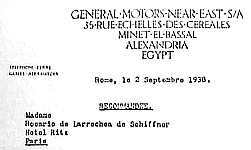
Letterhead of the GM's facility in Egypt
|
Sure enough, the extra set of keys arrives a day later, under
cover of another letter from Emilio dated September 2, 1938.
Unfortunately, the Countess will be able to enjoy the splendid,
new V-16 town car for only one year before another of those horrid world wars
breaks out in Europe.
She decides to move "temporarily" to Naples, with her
car. Although her late husband was German, Rosario can not put up with the arrogance
of those high-ranking officers of the German occupation force, the Wehrmacht and
Himmler's Waffen SS [the Schutzstafell] many of whom have have taken
over most of the rooms at the Ritz.

Retour à Paris
The Countess returns to the Ritz in the summer of 1945, after the
liberation of Paris by the allies. Her faithful Alessandro had been conscripted in 1939
and it was with heavy heart that she had learned from his bereaved mother that he had been
killed during the allied onslaught on Anzio.
But Alessandro is soon replaced with André, a French
chauffeur who hails from Ajaccio in Corsica; his manners are impeccable and he is totally
fluent in Italian.
Over the next three years the Cadillac town car clocks up some
30,000 kilometers, much of them stemming from the twice annual, two-day trips back and
forth between her suite at the Ritz and her palatial home in Rome.
On those trips the Countess always spends a couple of days at
Eze-Bord-de Mer, on the Côte d'Azur's Lower Corniche (the seaside route). She
always receives a warm welcome at Cap Estel, the seafront palace
once owned by wealthier-than-thou Count Sergei Stroganoff who had fled mother Russia
twenty years earlier, amid the Bolshevik revolution of 1917.
During all that time the heart of the Cadillac never missed a beat
and although fuel consumption was high, the cost was largely compensated by the utter
silence and smoothness of travel in the car's sumptuous rear compartment.

The Holy See, Italy
Sadly, as fall fell upon the Eternal City [what causing it any
serious damage!] in September 1948, the Countess succumbed to old age and a brief illness,
while she was visiting with her daughters in Rome. The pious girls acceded to one of their
late mother's last wishes and bequeathed the then 10-year-old Cadillac to their old family
friend, Cardinal Spellman of New York, whom they had entertained often on his frequent
trips to the Vatican.
The Cardinal was allowed to keep the car in the garage of the Holy
See. It sat there next to Pope Pius XIIth's custom-built 1940
Cadillac "throne car". History does not say whether "Pius"
the Pope ever met or thanked the "pious" Misses De Schiffner for their generous
gift, nor has it been ascertained if he ever rode in the mammoth town car.
The town car was first registered to the governing authorities [il
governatorato] of the City-State of the Vatican on August 26, 1949, when it was
already eleven years old. It was assigned license tag #SCV 289 [SCV = Stato della
Città del Vaticano or Vatican City State].
On February 15, 1950 it was transferred to Cardinal Clemente
Micara of the Roman College and assigned a new license tag: #SCV 32. Cardinal Micara did
not keep the car very long; on November 9, 1950 it went back into ownership of the Vatican
State authorities and was assigned yet another license tag: #SCV 13. The
Pope's official vehicle carried #SCV 1, although on occasion he would ride
in other Vatican-registered automobiles; it is possible he may have ridden in the
town car, although it was neither commissioned by the Vatican nor was the
Hole See the car's first owner.

H.H. Pope Pius XII, circa 1938
[ Photo: Fortune
magazine ]
|

Rome, Italy
In the Fall of 1966, with a view to making room for a more modern
fleet of Papal cars, many of the older ones were sold off, including the 1938 sixteen.
Indeed, on September 9, 1966 the car changed hands once again, being acquired by
well-known Roman automobile collector, Nicola Bulgari of jewelry fame. It is
believed he paid the
"outrageous" sum of 50,000 Lire for the car! In those days, that was the equivalent of
about ... $200!
The photos below were taken during
Mr. Bulgari's first period of ownership of the car
from 1966 to circa .....
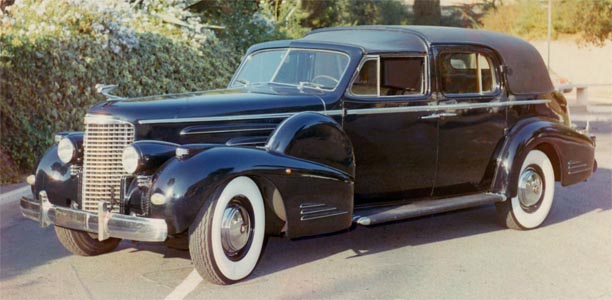
The oval fender-mounted parking lights [at bumper level]
and the small marker lights above
the front wheel openings
are non-original; these were
required to be able to license the car in Italy;
a new style parking lamp
was installed in France; the latter are
still on the car at this writing
[ Photos: courtesy Sig. Nicola Bulgari, Rome ]
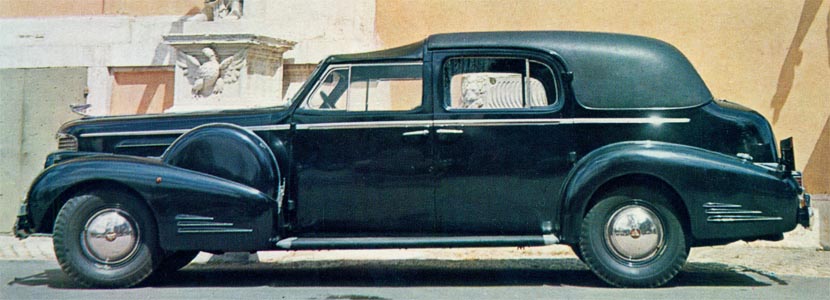

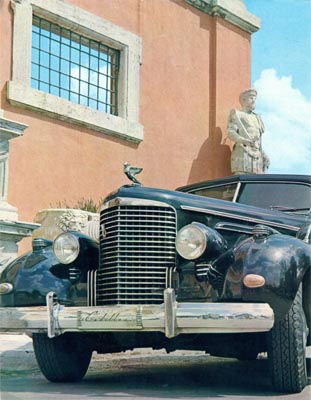
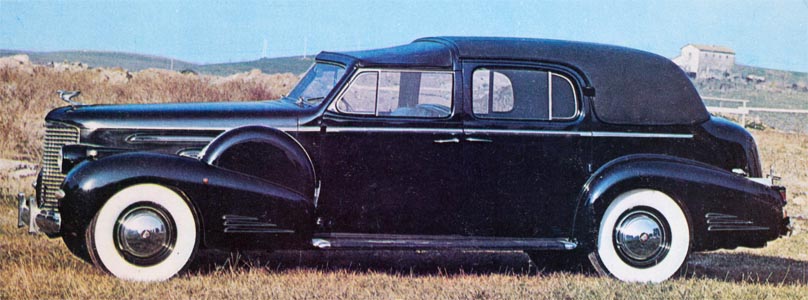
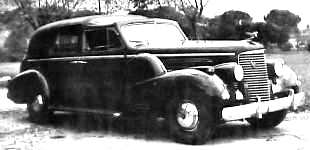 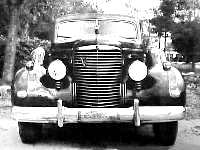

Temporary tag reads Prova - Roma 626
[prova means "test"]
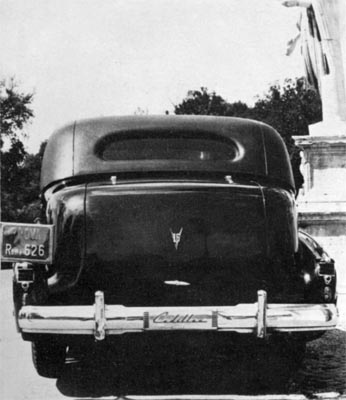
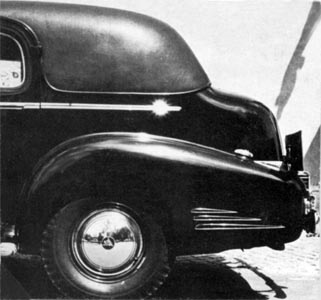
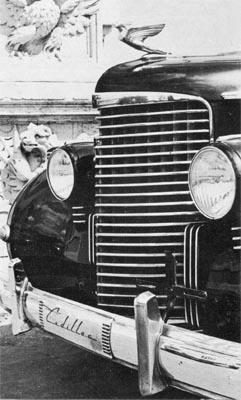
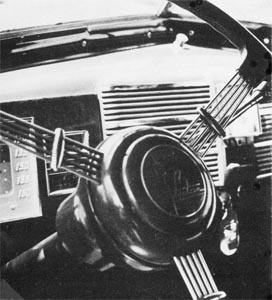 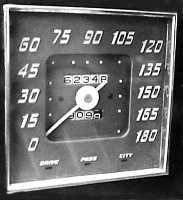
Note KPH speedometer, far right; quite uncommon on
any V16
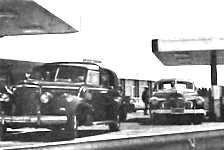 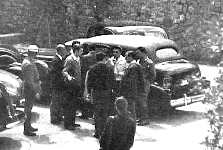
Club meting at the Pelican Hotel,
circa1966-67
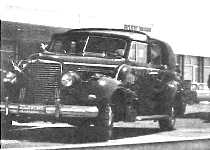 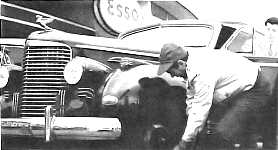
Right: Nicola checks tire pressure during an outing of
the Roman Classic Car Club
|
In an interview he gave in 2011 to the Caddie Chronicle
(the Newsletter of the Cadillac & LaSalle Club, Potomac Region), Nicola tells
how, when he was 25, he bought his first
Cadillac - this very car. He later sold the V-16 some 15 years later, but said
he would add another to his collection if he found the right one. He said, “It
was quite an experience to drive that car because the quality was second to none,”
Bulgari said. “The suspension design, the power, the engine... Everything was built
with extraordinary quality.”
3
_______________________________________________________
3 From a conversation I had in March 2012,
with Mr. Keith Flickinger, it would appear that Mr. Bulgari re-purchased
the town car from a previous owner. My daughter azttended an auction at
Villa d'Este on Lake Como

St. Marcel-les-Valence (Lyons), France
In the early eighties,
having decided to thin down his collection, Mr. Bulgari accepted an offer for the car from
a French tanker-truck operator, Monsieur Lambert, a resident of St. Marcel-les-Valence,
located just south of Lyons in central France.
Mr. Lambert was a keen auto
enthusiast and had built up over the years quite a sizeable collection of classics which
he then converted to a small, private museum, charging a modest viewing fee to the public.
But his modest museum
undertaking came under the scrutiny of the new socialist French government, under
President François Mitterand. Heavy taxes soon began to be levied on the
Government's appraised value of the collection, forcing Mr. Lambert to close the museum -
to the detriment of aficionados like you and me - and to sell off the majority of its
holdings.
Such is the unsound
reasoning of the socialists. Kill the entrepreneurs with taxes; deprive the people of jobs
... and then wonder why the nation is in such a sorry state !

Letterhead from the Lambert Company that
contacted me in 1982 to get specific
information about the so-called "Vatican V-16"
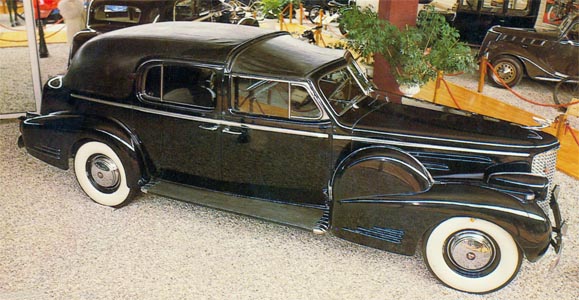
This is a (cropped) postcard from the former
museum collection of Mr. Lambert
|

Geneva, Switzerland
Mr. Lambert consigned a
number of his cars for sale at auction by Sotheby's of London, on Monday March 7, 1988, during the Geneva Auto salon. It was listed in the catalog as The Pope Pius XII
Cadillac V-16 Ceremonial Town Car, coachwork by Fleetwood. The catalog entry
reads further: [the car] ... is described as being used by His Holiness Pope Pius XII and ... a St. Christopher medallion is mounted on the dash panel. In the humble opinion of
this writer, there is nothing Papal about that particular medallion; it was a popular item
on the majority of cars owned by Roman Catholics (especially Italians) in the fifties and
sixties.
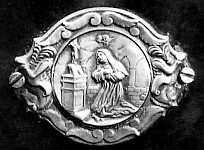
"St. Christopher"
patron saint of travellers
dash ornament
It has not been determined who installed the
St. Christopher medallion
on the dash
Mr. Bulgari?
|

Aarau, Switzerland
I attended the Sotheby's
auction and watched in awe as bidding appeared to climb to around $120,000. But no
actual sale ensued. The car was subsequently sold privately to a Mr. Amman of Aarau,
in Switzerland. This contradictory snippet appeared in a specialized
hobby publication shortly after the alleged sale [I was there and can guarantee
there was a NO SALE]. The text (in French) reads: This aggressive
insect-like face is the front of a "Papal" Cadillac (it used to belong to Pope
Pius XII). It has just been sold for 90 million [old] French francs
[at that time about $120,000] during an auction sale of historic cars in Geneva. Now
there's a Pope who didn't travel in any old car ! One thing for sure, it certainly is more
elegant than the current "Popemobile"
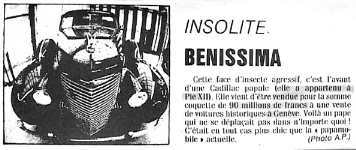
Cutting from the Geneva auction in 1988
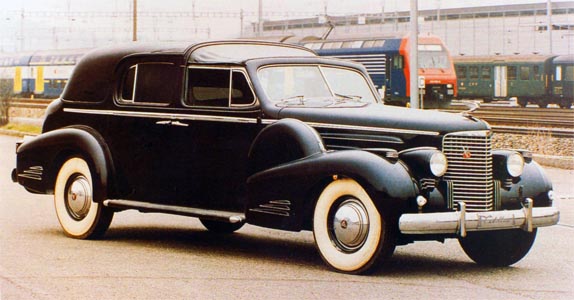
By the railroad tracks, somewhere in
Switzerland, circa 1988-89
|
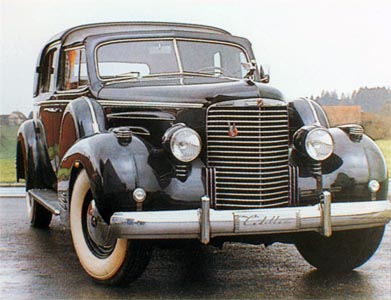
The car spent some time in Switzerland,
after it was sold by Mr. Lambert
|
Before the car could be
registered for use on Swiss highways, some minor modifications were needed. These included
replacing the small, oval turn-signal lamps at the base of the front fenders with circular
ones [from what I have seen, the latter are still mounted on the car today].

Back "home" to the USA
In the nineties, the car
returned briefly to France where it was in the possession of classic car dealer, J.-F.
Dumontant. During that time, it was acquired by a U.S. collector. In 2004
(and perhaps even before that) the town car had found anew home the USA,
where it was cared for by Richard Beguhn.
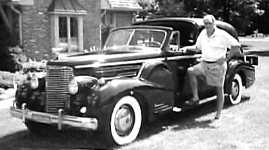
Unidentified owner (Mr. Beguhn)
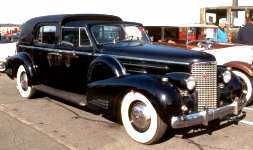 
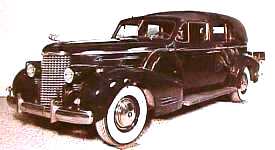 
These are photos of the car when it was in the
ownership of Mr. Beguhn;
it was still in mostly original condition with around 50K miles on the odometer
|

Auburn, IN - 2006
The "Vatican V-16"
was advertised for sale by the Kruse auction people. It was to cross the block at Auburn,
IN, in the fall of 2006 [August-September]. I had to thank Hemmings' David Traver Adolphus
for informing me of the coming sale of this interesting historic vehicle.
According to the auction results, a "1938 Town Car used by Pope Pius XII"
sold for $250,000 - a far throw from the $200 paid for the car
exactly 40 years earlier by the Italian jewelry tycoon. The buyer was
millionnaire lawyer, John O'Quinn. Mr. O'Quinn also
added to his collection on that occasion, a 2005
Lamborghini
Gallardo covered with 33 celebrity autographs ($500,000),
the
Batmobile
used inthe filming of
Batman Forever
($335,000), a 1941
Packard
limousine used by President
Franklin D.
Roosevelt ($290,000) and
a 1938
Talbot-Lago
($3,350,000)!
Sadly, Mr. O'Quinn died in an auto accident some 3
years latetr. The RM auction people were entrusted with selling his vast collection (800 or more cars worth
around $100 million.
BTW, the Kruse auction catalog description of the car said the
first owner (not named, but presumably Countess De Larrechea De Schiffner) had passed away in 1948 and willed the Cadillac to Cardinal Spellman of
New York. Mr. Bulgari said in 1966 that the car had been willed to the
Countess' two daughters ... who tem bequeathed it to
Spellman. The catalog description in the auction listing asserts that the
Cardinal "then commissioned it to the Vatican." History does not say
whether the Pope ever took a single ride in the "old" V-16; after
all, his official "Throne Car" was a younger, custom built Cadillac.
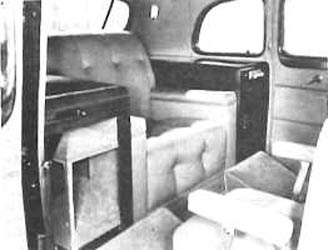
Pope Pius XII's "Throne Car";
a less ostentatious Cadillac Fleetwood Series 75
limousine, albeit with sumptuous interior appoinments
|

Villa d'Este,
Como - 2011
I had found questionable the mileage declared (by the Kruse
auctioneers) in 2006. It was off indeed that the car should have
registered only 34,000 mi, considering it had covered already 39,000 miles (62,348kms)
according to the odometer reading under Nicola Bulgari's ownership (photo of
instrument panel, above). Perhaps the Kruse people are not good at
math.
Nevertheless, the RM
catalog image of the instrument board for the 2011 auction at Lake Como (and
dating from late 2010), indicates that in the 25-odd
years since the car was in Mr. Bulgari's first ownership, it traveled a mere 124kms (77.5
miles).
At that auction sale, which was attended by my daughter, Kelly, she noticed
that the "Papal" car appeared to have acquired French license tags (again?),
this time from the Var region, that stretches East along the French Mediterranean
from St. Cyr-sur-Mer to St. Raphaël ... via Brigitte Bardot's St. Tropez.
Were not these the tags used by Mr. Lambert, in
1982-83?
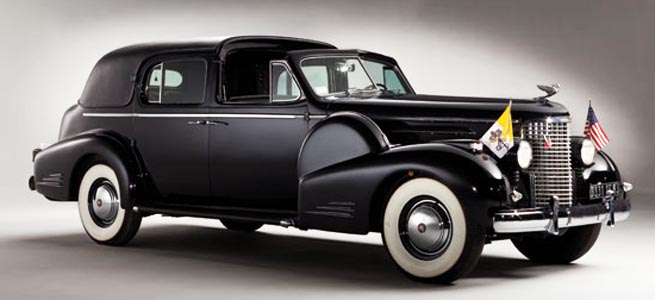

These photos
©2011 and courtesy of RM auctions;
Note that the car carries still the French license tags issued to Mr. Lambert
who bought the car from Mr. Bulgari in the late 70s

Here is well-lnown collector, Nicola Bulgari himself.
I learned in Amelia Island, in March 2012,
that he had bought the car back
... 30 years later
|
Many of the persons with
whom I have spoken about this car over the years continue to deny the evidence (i.e. the actual invoice
copy as well as copies of authentic letters from GM in Alexandria, Egypt, to the first
owner, Countess de Larrechea de Schiffner). There can be absolutely no doubt that this car
never was ordered by Pope Pius XII nor delivered to the Vatican for his personal use.
But of course it's worth a
helluva lot more money if you can convince a buyer that it once belonged to the Pope
himself!
Hallelujah!
Amen!

Believe it or not, this is a scale replica of
the so-called
"Vatican V16 town" car; it is believed to be made by Anson, in
Thailand, in their Signature series; it is authentically
detailed down to even the repair patches on the
quarter panel areas of the leather roof
|

Return to The (New)
Cadillac Database© Index Page
or to the "V-16"
index page
© 1996, Yann Saunders and
the Cadillac-LaSalle Club, Inc.
[ Background image: The so-called "Vatican V-16" ]
![]()
![]()
![]()






















